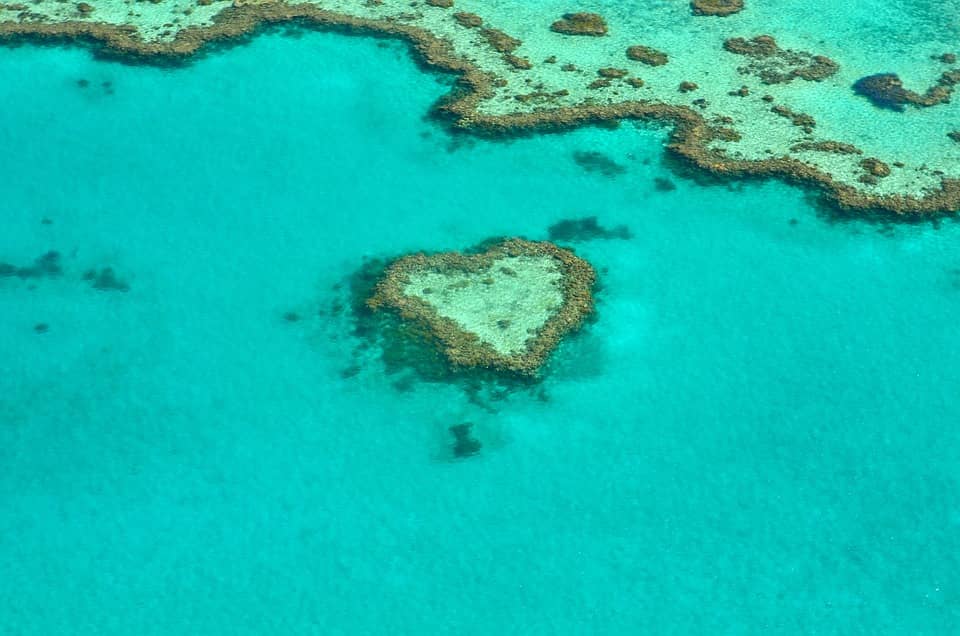A new addition to your must-visit bucket list!
Spanning over 2,300km along Australia’s eastern coastline, the Great Barrier Reef is a breathtaking natural wonder and one of the most popular destinations in the world. As the largest coral reef on earth, it is located in the Coral Sea off the coast of Queensland and is so magnificent that it can even be seen from outer space. The coral polyps have created a true masterpiece, with over 400 coral species and 4,000 species of mollusk, providing a home to a diverse range of marine life. The reef is also a vital habitat for 240 species of birds, 134 species of sharks and rays, and 30 species of marine mammals, including whales, dolphins, and the vulnerable dugong. It is also a nesting ground for 6 species of sea turtles. This vibrant underwater ecosystem is a must-visit for all nature lovers and adventure seekers.
What are coral and a barrier reef?
A coral is a marine invertebrate animal that forms a hard calcium carbonate skeleton to protect its soft body. Coral reefs are made up of colonies of coral and other organisms like algae, sponges, and mollusks. These reefs provide vital habitat and shelter to thousands of species of marine life and are some of the most biologically diverse and economically important ecosystems on the planet.
A barrier reef is a type of coral reef that forms along the coast of a continent and runs parallel to the shore. Unlike fringing reefs that grow directly along the shoreline, barrier reefs are separated from the shore by a lagoon or channel of water. The Great Barrier Reef in Australia is the largest and most famous example of a barrier reef. Barrier reefs provide important physical protection from wave energy, storm surges, and other environmental stressors and are critical habitats for many species of fish, marine mammals, and other wildlife.
Best season to visit GBR
The best time to visit the Great Barrier Reef depends on the type of experience you are looking for. The peak tourist season is from June to September, when the weather is warm, and the water is clear, making it ideal for swimming, snorkeling, and diving. This is also when the coral is most colorful and has the highest concentration of marine life.
For those looking to avoid crowds, the shoulder season from March to May or October to November is a good time to visit. The weather is still pleasant, and there are fewer tourists, making it a great time to explore the reef at a more leisurely pace.
The winter months, from June to August, can be cooler, but they are also the best time to spot whales and other marine mammals as they migrate along the coast. Overall, the Great Barrier Reef is a year-round destination; the best time to visit will depend on your personal preferences and interests.
How to observe the reef without harming it?
Seeing the Great Barrier Reef is a once-in-a-lifetime experience, and ensuring that your visit has minimal impact on this delicate ecosystem is important. Here are some tips on how to see the reef without harming it:
Choose an eco-friendly tour operator: Look for operators who prioritize sustainability and have environmentally friendly practices, such as using reef-friendly sunscreens and following strict marine park guidelines.
Respect the reef: Avoid touching or standing on the coral, and keep a safe distance from marine life. This helps to prevent damage and disturbance to the reef and its inhabitants.
Use snorkel fins carefully: When snorkeling, be mindful of your fins and avoid kicking up sand or sediment, which can harm the coral and reduce visibility.
Don’t feed the fish: Feeding marine life can disrupt the ecosystem’s natural balance and lead to overpopulation.
Support conservation efforts: Consider donating to organizations protecting and preserving the reef.
Perks of visiting GBR
Visiting the Great Barrier Reef is an unforgettable experience that offers endless perks. Imagine swimming amongst the stunning coral formations, giant clams, and rare species of whales, all while encountering six of the world’s seven marine turtle species. Whether you’re a thrill-seeker looking to scuba dive to the depths of the ocean, or a sunbather who just wants to relax on the soft white sands of an island, the Great Barrier Reef has something for everyone. The reef offers a unique combination of adventure, relaxation, and natural beauty that is unmatched worldwide.
Things to do
Visiting the Great Barrier Reef is an experience like no other, where you can witness the beauty of nature, blue water and protect this wonder with minimal impact. Take a step back from the chaos of daily life and focus on conserving this magnificent ecosystem as you explore the Southern Hemisphere’s only submerged art gallery. Immerse yourself in the crystal clear waters of the reef, snorkeling and diving amongst the vibrant coral formations, colorful fish, and marine life. Escape the crowds and find a quiet place to relax or explore the ocean’s depths with a scuba dive. For the adventurous at heart, take a helicopter ride, enjoy a private island picnic, boat trips and encounter marine life like never before. The Reefsleep experience offers the unique opportunity to spend a night on the reef, sleeping under the stars, surrounded by the sounds of the ocean. Travel underwater in a mini-submarine and ride an underwater scooter to explore the reef like never before. Swim with minke whales, witness sea turtles hatching, and skydive over the reef for an unforgettable adventure. Experience the beauty of the Great Barrier Reef and leave feeling inspired and rejuvenated.
Great barrier reef islands
The Great Barrier Reef is habitat to the world’s most extensive coral reef system, a chain of 600 continental islands, 300 coral cays, and 150 inshore mangrove islands. These islands offer a unique and diverse range of experiences, from adventure-filled days to peaceful and serene escapes. The Whitsunday Islands are a group of 74 tropical islands with dazzling white beaches and turquoise waters, perfect for swimming, snorkeling, and sailing. The tropical paradise of Lizard Island is located in the northern part of the reef, offering secluded beaches, stunning coral formations, and an abundance of marine life. Heron Island is a picturesque coral cay surrounded by lush tropical vegetation and spectacular reef views. Lady Elliot Island is an eco-friendly island, home to over 1,200 species of marine life and surrounded by crystal clear waters perfect for snorkeling and diving. The Great Barrier Reef Islands are an ideal blend of adventure, relaxation, and natural beauty, offering something for everyone. Visit Fitzroy Island, it is a tropical island located in the Great Barrier Reef Marine Park, off the coast of Cairns in Queensland, Australia. It is a popular tourist destination known for its lush tropical rainforest, crystal clear waters, and abundant marine life.
GBR is in danger!
The Great Barrier Reef, one of the world’s greatest wonders, is facing numerous threats that threaten its existence. Coral bleaching is a phenomenon where coral reefs are exposed above the water’s surface due to sea level changes or severe weather conditions. This event can have devastating effects on the Great Barrier Reef, as coral reefs provide a vital habitat for a vast array of marine life and play a critical role in maintaining the health of the ocean ecosystem. The loss of coral reefs can also have a significant impact on coastal communities, as coral reefs serve as a natural barrier against storms and erosion, protect shorelines and provide food and tourism revenue. Climate change, pollution, loss of coastal wetlands, and pollution from mining all contribute to the reef’s decline. The crown of thorns starfish is also having a significant impact on coral polyps, reducing the ability of the reef to recover. Shipping accidents and shark culling only add to the stress on the reef. It is up to all of us to be aware of these threats and work towards finding solutions to conserve this magnificent ecosystem for future generations to enjoy. The Great Barrier Reef is a valuable natural resource, and our responsibility is to protect it.
How can you contribute to preserving it?
The Great Barrier Reef faces numerous threats, but measures are in place to protect it. The Reef 2050 Plan and the Reef 2050 Water Quality Improvement Plan are initiatives by the authorities to protect and conserve the reef. The Australian government, UNESCO, and other parties are also taking steps to protect the reef. Additionally, under the Native Title Act 1993, native title holders retain the right to legally hunt dugongs and green turtles for “personal, domestic or non-commercial communal needs.” However, there are also things individuals can do to help protect the Great Barrier Reef. One can participate in reef-friendly activities, such as choosing sustainable tourism options, reducing single-use plastics, and supporting organizations working towards conserving the reef. We can all help protect this magnificent ecosystem for future generations by taking small steps.
Conclusion
The Great Barrier Reef is a unique and breathtaking natural wonder that should be on everyone’s bucket list. It is a vital habitat for a diverse range of marine life, including rare species of whales, dolphins, and sea turtles. With so much to see and do, from snorkeling and diving to island picnics and helicopter rides, the Great Barrier Reef is a must-visit destination for nature lovers and adventure seekers alike. Always choose eco-friendly tour operators, respect the reef, use snorkel fins carefully, and support conservation efforts to help preserve this magnificent ecosystem for future generations. A visit to the Great Barrier Reef is a once-in-a-lifetime experience that will leave you in awe of the wonders of the ocean.

